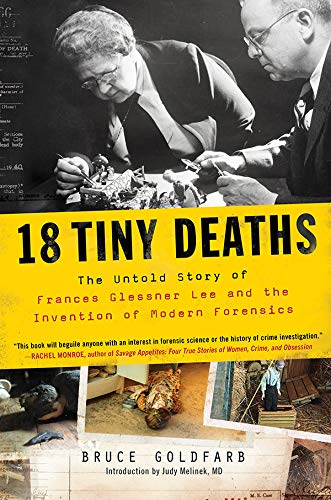18 Tiny Deaths
Forensic medicine is a familiar concept today to anyone who reads mystery novels or watches police procedural dramas on television. But as recently as 1944 only one to two percent of the questionable deaths in the United States were investigated by qualified medical examiners. In 18 Tiny Deaths: The Untold Story of Frances Glessner Lee and the Invention of Modern Forensics, journalist Bruce Goldfarb tells the story of how an elderly woman with no formal education became the unlikely crusader behind the development of modern forensic science in the United States.
It takes a good half of the book before Frances Glessner Lee is introduced to the subject that would be her passion. It is time well spent. Goldfarb paints a picture of Lee as a child of the Gilded Age in Chicago, with all the privileges and restrictions that entailed. (Unable to attend Harvard, she chose not to attend college at all.) He traces the history of how questionable deaths were investigated through the early twentieth century. The two threads come together in the person of her childhood friend, Dr. George McGrath, who was Boston’s second medical examiner. McGrath introduced Lee to what was then called “legal medicine,” telling her stories of finished cases and describing his frustrations with the haphazard use of forensics in police work. She was hooked, both by the stories and by the need for an institutional structure for educating both medical examiners and the police in the principals of forensic medicine.
McGrath may have felt he created a monster. Lee dedicated the next 30 years to developing what she called the “three-legged stool” of legal medicine: medicine, the law, and the police. She used the techniques she learned from her mother’s patronage of the Chicago Symphony to alternately seduce and bludgeon Harvard Medical School into founding a department of Legal Medicine. But she wanted to do more than give money. She insisted on hands-on involvement, culminating in the “18 tiny deaths” of the title: eighteen detailed dioramas known as the Nutshell Studies of Unexplained Death, which Lee created as tools for training police officers in modern scientific forensic methods.
Late in her life, Lee claimed, “Men are dubious of elderly women with a cause.” 18 Tiny Deaths is the fascinating story of how much such a woman can accomplish.
You may never watch a police procedural the same way again.
The guts of this review appeared previously in Shelf Awareness for Readers





